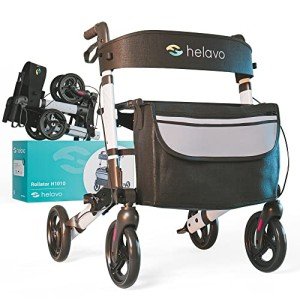What's The Fuss About Ergonomic Walker?
The Benefits of Non-Slip Walkers: Enhancing Mobility and Safety for All
As we navigate through the diverse landscape of mobility help, one vital item stands out: the non-slip walker. This necessary tool not just help those with minimal mobility but also promotes independence and safety. In this article, we will explore the benefits of non-slip walkers, the various types offered, and what features to search for when picking the best walker. Along the way, we will answer regularly asked concerns and supply insights that improve understanding of this crucial mobility device.
Why Choose a Non-Slip Walker?
Non-slip walkers are particularly developed with security in mind. Slips and falls can cause major injuries, especially for elderly individuals or those recuperating from surgical treatment. Including anti-slip features into a walker can drastically reduce the danger of mishaps, making it a crucial choice for anybody in requirement of assistance. Here are a couple of factors why a non-slip walker is a deserving investment:
- Enhanced Stability: Non-slip grips and rubberized wheels supply exceptional traction on different surfaces.
- Improved Safety: The design lessens the possibility of slips, providing users self-confidence as they move.
- Increased Independence: Those who might have formerly relied on caregivers can gain back some degree of autonomy.
- Versatile Design: Non-slip walkers can be tailored to fit a range of personal needs and choices.
Types of Non-Slip Walkers
Non-slip walkers come in numerous designs, each customized to accommodate various mobility requirements. Below is a contrast table highlighting the most common kinds of non-slip walkers offered:
Type of Walker
Features
Perfect For
Cost Range
Standard Walker
Four legs, lightweight, rubber ideas
General use, moderate assistance
₤ 50 – ₤ 100
Two-Wheeled Walker
2 front wheels, 2 rear legs with rubber pointers
Individuals who need assistance however can walk
₤ 70 – ₤ 150
Rollator
Four wheels, braking system, seat choice
Active people; offers a rest option
₤ 100 – ₤ 250
Knee Walker
Designed for people with knee injuries
Short-term healing from leg or foot injuries
₤ 80 – ₤ 200
Pediatric Walker
Smaller sized size, colorful styles
Children with mobility problems
₤ 60 – ₤ 120
Aspects to Consider When Choosing a Non-Slip Walker
Selecting the best non-slip walker can be an overwhelming job. Here are some factors to bear in mind when deciding:
- User's Weight and Height: Ensure that the walker supports the user's weight and matches their height.
- Type of Surface: Consider where the walker will be mainly utilized (inside your home vs. outdoors) to pick an appropriate tire configuration.
- Mobility and Weight: If the walker needs to be transported, think about weight and foldability for convenience.
- Adjustability: Look for a walker that can be adapted to the user's specific height needs, making sure comfort and security.
- Additional Features: Some walkers consist of features such as built-in seats, storage baskets, or more advanced braking systems.
Extra Features of Non-Slip Walkers
While analyzing non-slip walkers, numerous additional features can enhance user experience:
- Ergonomic Grip Handles: Soft and comfortable grips can lower strain on the hands.
- Reflective Materials: Adding increased presence can help those who might be utilizing the walker in low-light conditions.
- Personalized Accessories: Consider options like cup holders, trays, or perhaps oxygen tank holders for added convenience.
- Sturdiness: Look for walkers constructed from high-quality materials to ensure long-lasting use.
Frequently Asked Questions (FAQs)
1. What is the main difference between a basic walker and a rollator?
- A standard walker has four legs and requires the user to raise it with each action, whereas a rollator has wheels, permitting the user to press it along more easily.
2. Are non-slip walkers appropriate for outdoor usage?
- Yes, lots of non-slip walkers are developed for different surface areas. It's crucial to pick a model with appropriate wheels for outdoor terrain.
3. Can a non-slip walker be utilized by individuals who have had hip or knee surgical treatment?
- Absolutely. Non-slip walkers supply stability and can be vital for those recuperating from such surgeries.
4. How do I adjust the height of a walker?
- The majority of walkers include adjustable legs that allow you to alter the height. Describe Stable 4-Wheel Walker for specific modification guidelines.
5. Exists a weight limitation for non-slip walkers?
- Yes, each walker has actually a defined weight limitation. It is very important to thoroughly inspect this information before purchasing to guarantee security.
6. Can I utilize a non-slip walker in stores or public places?
- Yes, non-slip walkers are designed for use in different environments. Just ensure the design you pick is maneuverable enough for confined spaces.
Investing in a non-slip walker can offer users with boosted mobility, self-confidence, and self-reliance. The range of designs and features offered permits users to pick a walker that best fits their distinct requirements. By considering aspects such as weight capacity, adjustability, and extra features, one can ensure that they or their loved ones are safe and comfortable.
For those seeking to regain their self-reliance, non-slip walkers not only aid in mobility but also contribute to a more active way of life. If you or someone you know might gain from a non-slip walker, make the effort to check out the options readily available— your journey towards increased security and autonomy starts here!
